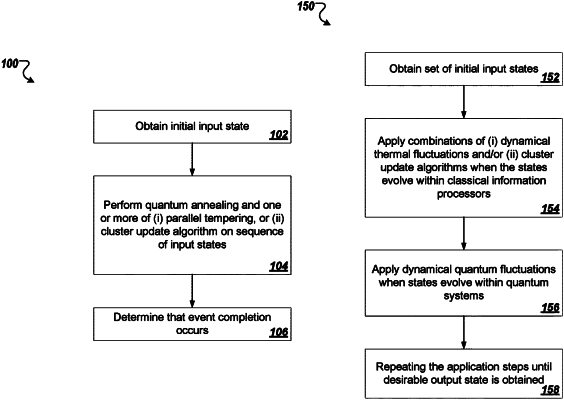| CPC G06N 3/126 (2013.01) [G06N 5/01 (2023.01); G06N 10/60 (2022.01)] | 18 Claims |

|
1. A method performed by classical information processors, the method comprising:
for a graph partitioned into one or more local regions, the graph representing a quantum system included in a quantum processor, the quantum system comprising a plurality of interacting qubits, wherein the plurality of qubits are represented by respective nodes in the graph, interactions between qubits are represented by respective edges between nodes, a ground state of the quantum system encodes a solution to an optimization task, and the graph is partitioned into the one or more local regions according to a division of the optimization task and embedding capabilities of the quantum processor:
repeatedly, until a target output state that approximates the ground state to within a predetermined threshold is obtained:
applying one or more of (i) dynamical thermal fluctuations or (ii) cluster update algorithms to an initial input state of the quantum system or a subsequent input state to obtain a classically evolved state for the repetition;
for each local region, determining whether application of the (i) dynamical thermal fluctuations or (ii) cluster update algorithms are failing to overcome one or more energy barriers in an energy landscape at a given temperature, wherein each energy barrier of the one or more energy barriers is associated with a respective local region of the one or more local regions;
for each local region for which it is determined that the application of the (i) dynamical thermal fluctuations or (ii) cluster update algorithms has failed to overcome one or more energy barriers, providing the classically evolved state for the repetition to the quantum processor for application of dynamical quantum fluctuations to the classically evolved state for the repetition, wherein the dynamical quantum fluctuations are only applied, at the given temperature, to qubits of the quantum processor that are represented by graph nodes in the local regions of the graph that are associated with the one or more energy barriers that application of the (i) dynamical thermal fluctuations or (ii) cluster update algorithms fail to overcome;
obtaining, from the quantum processor, an output state;
determining whether the output state is the target output state; and
in response to determining that the output state is not the target output state, providing the output state as an input state for a subsequent repetition; or
in response to determining that the output state is the target output state, determining a solution to the optimization task through measurement of the output state.
|